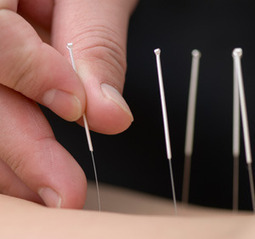Chinese Acupuncture Is “Theatrical Placebo”, Study Finds
See on Scoop.it – Virology and Bioinformatics from Virology.ca
Pain is a big problem. If you read about pain management centers, you might think it had been solved. It has not, yet. And when no effective treatment exists for a medical problem, it leads to a tendency to clutch at straws. Research has shown that acupuncture is little more than such a straw.
Although it is commonly claimed that acupuncture has been around for thousands of years, it has not always been popular, even in China. For almost 1000 years, it was in decline, and in 1822, Emperor Dao Guang issued an imperial edict stating that acupuncture and moxibustion should be banned forever from the Imperial Medical Academy.
Acupuncture continued as a minor fringe activity in the 1950s. After the Chinese Civil War, the Chinese Communist Party ridiculed Traditional Chinese Medicine, including acupuncture, as superstitious. Chairman Mao Zedong later revived Traditional Chinese Medicine as part of the Great Proletarian Cultural Revolution of 1966. The revival was a convenient response to the dearth of medically trained people in postwar China and a useful way to increase Chinese nationalism. It is said that Chairman Mao himself preferred Western medicine. His personal physician quotes him as saying “Even though I believe we should promote Chinese medicine, I personally do not believe in it. I do not take Chinese medicine.”
The political, or perhaps commercial, bias seems to still exist. It has been reported (by authors who are sympathetic to alternative medicine) that “all trials [of acupuncture] originating in China, Japan, Hong Kong, and Taiwan were positive.”
Acupuncture was essentially defunct in the West until President Nixon visited China in 1972. Its revival in the West was largely a result of a single anecdote promulgated by journalist James Reston in the New York Times after he had acupuncture in Beijing for postoperative pain in 1971. Despite his eminence as a political journalist, Reston had no scientific background and evidently did not appreciate the post hoc ergo propter hoc fallacy, or the idea of regression to the mean.
After Reston’s report, acupuncture quickly became popular in the West. Stories circulated that patients in China had open heart surgery using only acupuncture. The Medical Research Council (UK) sent a delegation, which included Alan Hodgkin, to China in 1972 to investigate these claims, about which they were skeptical. The claims were repeated in 2006 in a British Broadcasting Corporation TV program, but Simon Singh (author of Fermat’s Last Theorem) discovered that the patient had been given a combination of 3 very powerful sedatives (midazolam, droperidol, fentanyl) and large volumes of local anesthetic injected into the chest. The acupuncture needles were purely cosmetic.
Curiously, given that its alleged principles are as bizarre as those on any other sort of prescientific medicine, acupuncture seemed to gain somewhat more plausibility than other forms of alternative medicine. As a result, more research has been done on acupuncture than on just about any other fringe practice.
The outcome of this research, we propose, is that the benefits of acupuncture are likely nonexistent, or at best are too small and too transient to be of any clinical significance.
See on www.anesthesia-analgesia.org
